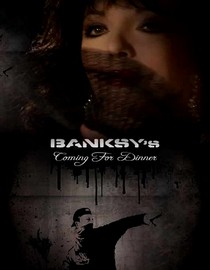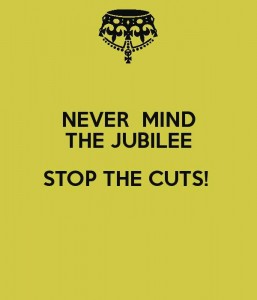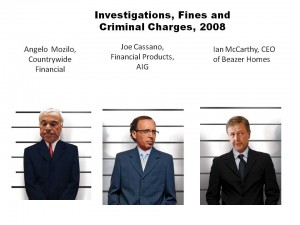At first thought I wanted to blast this film for being so horrible. Badly acted, awkward, forced dialogue, a ridiculous premise, and without thinking about what the film was trying to accomplish it seems like it was just a whole bunch of British celebrities attempting to show how magnificent they were in front of Banksy. But again, this was at first thought. Given a second, or possibly third, thought, Banksy’s Coming to Dinner is much more complex than at first glance. The premise is simple: Joan Collins and her husband are have a “leisure” dinner and invite over a diverse group of five celebrities (none of whom you would know unless you were familiar with British popular culture). The guest of honor, though, as the title of the film suggests, is Banksy.
The very name for the past decade had elicited a wild spectrum of responses from those who absolutely hate his work and what he represents to those who love him and even those who don’t necessarily quite understand him. This film represents that third pool of people, the one where society doesn’t understand him. And that’s part of the mystique that makes Banksy, the elusive artiste of the new century, such a marvel. A man who, if he were to unveil his identity, would become the single most popular and well-known face not only in the art world but everywhere. An instant celebrity most have said. But at the same time if he were to unveil himself and expose his identity, he would also be the most wanted (in legal terms), being wanted in at least six different countries for various charges. If exposed, while he could be celebrated, he would also face up to at least two-hundred years in jail. That, as the Wooster Collective first mentioned in 2007, is the Banksy Effect. It’s the paradox of society. It’s the paradox mentioned and underlined and punctuated by the film, Banksy’s Coming to Dinner.
 Now obviously it wasn’t really Banksy in the film. The UK and all its media affiliates had a field day when this film first came out two years ago about whether or not it was really him. But it was all just jazz and hot air to sell their magazine or paper. In actuality Banksy is played by Bryan Lawrence. The entire time his face is blurred and his voice is dubbed over so you can’t really tell—which was the point—and thus lends itself to the effect that the mockumentary has. That effect of course being to emphasizes society as this force of bewilderment that places anything of intrigue on a pedestal and is eventually let down and disappointed when confronted with their object of affection. If Banksy were to actually reveal himself, the appeal would certainly fade just as fast as it took to take his picture and (if you’re a Donald Trump fan) confirm his birth certificate.
Now obviously it wasn’t really Banksy in the film. The UK and all its media affiliates had a field day when this film first came out two years ago about whether or not it was really him. But it was all just jazz and hot air to sell their magazine or paper. In actuality Banksy is played by Bryan Lawrence. The entire time his face is blurred and his voice is dubbed over so you can’t really tell—which was the point—and thus lends itself to the effect that the mockumentary has. That effect of course being to emphasizes society as this force of bewilderment that places anything of intrigue on a pedestal and is eventually let down and disappointed when confronted with their object of affection. If Banksy were to actually reveal himself, the appeal would certainly fade just as fast as it took to take his picture and (if you’re a Donald Trump fan) confirm his birth certificate.
Banksy, as portrayed in the film, comes out looking snide and characterless, which disillusions the mystery that we’ve garnished around his myth; for he is a modern-day myth and not just an effect. In fact, Banksy, though he is talented and does have a message that deserves to be heard is as much a celebrity and myth as we allow him to be. What makes him more than an artist? Or even a graffiti stenciler? Us! That’s the big message, the one I completely missed when the credits rolled and I sat there stunned that I had just wasted an hour and ten minutes of my time to watch such an awful wreck. We have positioned not only Bansky but graffiti and post-graffiti to become this generation’s art movement, the essential staple within our society that declares our voice within the sphere of modernity and history. And for that, the film deserves to be seen; it’s the message and not how it’s played out that should be seen as the ultimate reason to watch this movie.
Banksy's Coming to Dinner,




